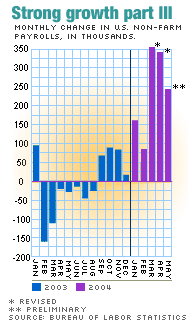NEW YORK (CNN/Money) -
Employers are adding jobs at the fastest pace in four years, a government report showed Friday, which is great for workers but could worry investors if it slows recent white-hot gains in corporate earnings.
Friday's Labor Department report showed an increase of 248,000 jobs outside the farm sector in May, compared with a revised gain of 346,000 for April. Economists surveyed by Briefing.com forecast the May report would show a 225,000-job gain.
The unemployment rate held steady at 5.6 percent, in line with economists' forecasts.
And the strength in the job market is starting to be seen in workers' paychecks.
For the second straight month average hourly wages rose 0.3 percent, last month to $15.64.
April job growth was revised up from a previous reading of 288,000 new jobs. The department also revised the number of jobs created in March, to 353,000 from a previous reading of 337,000.
That means the economy created 947,000 jobs the past three months, the best since 1.03 million jobs were added during the same three months of 2000, when the U.S. jobs market was the strongest in recent memory.
Will labor costs squeeze profits?
While the pickup in job growth is good for people on Main Street, the question for investors is what will happen to corporate profits.

Earnings should continue to grow but the rise in labor costs, and tougher comparisons with a year earlier, should mean an end to the big gains of recent quarters, economists said.
Earnings tracker First Call estimates that corporate earnings jumped 27.5 percent in the first quarter, and projects a 19.4 percent rise this quarter and 13.5 percent gain in the third quarter.
"I think we know corporate profit growth can't stay at the rate we've seen in recent quarters," said Ethan Harris, chief economist with Lehman Brothers. "They (employers) have been squeezing the work force pretty aggressively, squeezing productivity out of workers and holding the line on wages. It's a matter of how much corporate profits slow down."
Last month's increase in wages works out to about a 3.7 percent annual growth rate. But average wages have risen just 2.2 percent over the last 12 months, a sign that employers still have the upper hand in negotiating pay raises, according to economists.
"They (wages) are still not at levels we would expect at this point in an economic expansion," said Anthony Chan, chief economist with Banc One Investment Advisors.
| 
| |

| 
| 
|

|
 Employers added 248,000 jobs in May, while the unemployment rate held steady at 5.6 percent. CNNfn's Louise Schiavone reports. Employers added 248,000 jobs in May, while the unemployment rate held steady at 5.6 percent. CNNfn's Louise Schiavone reports.
|
 Play video
Play video
(Real or Windows Media)
|
| 
|

|
|
"The gap between wages and output is still large enough that corporate profits will be strong. I think there's no doubt that corporate profits are going to be squeezed. But it's not just because of labor costs."
Joe Cooper, research analyst with First Call, said that most employers are covering the cost of new hiring or wage increases with increased revenue, either from increased production or greater pricing power in the market.
"The feeling is they're comfortable enough that the top line is growing fast enough to accommodate hiring," he said.
In addition, the economy lost 2.4 million jobs over the last three years, leaving a big backlog of job seekers, which could limit wage gains.
One reason the unemployment rate is little changed despite nearly a million new jobs in the last three months is that many unemployed people are coming back into the job market.
"There is still a big backlog to be made up before it feels like a tight job market," said Bill Cheney, chief economist with MFC Global Investment Management. "Clearly it's a tighter job market than it was a year ago, and if we continue to add a million jobs a quarter, we'll move in that direction. But I think it will take a little bit of time."
And the Fed?
Last month's job gains were broad-based, with only government employment falling in the period. Manufacturing added 32,000 jobs and construction added 37,000, the department said in its report. Retailers added 19,000 jobs.
The monthly jobs report is closely watched by investors for clues to the economy's strength, and as to when the Federal Reserve will start raising interest rates.
The Fed, the nation's central bank, kept rates low through 2003, even as other reports showed relatively strong economic growth, because the weak job market helped keep inflation in check.
But with three months of strong jobs data, coupled with rising wages and prices, the Fed is widely expected to raise its target for a key short-term rate late this month, rather than waiting for its August meeting.
Friday's report did little to change that thinking.
On Wall Street, stocks rose and Treasury prices edged lower after the report, boosting the yield on the 10-year note to 4.75 percent from 4.71 percent late Thursday. Bond prices and yields move in opposite directions.
Analysts said the report just made them more certain that the Fed will raise the fed funds rate a quarter point at the June 30 meeting, not a half-point. The rate, an overnight bank lending rate, is at 1 percent, the lowest in more than 40 years.
"Nothing in this report tells things are running out of control," said Banc One's Chan.

|


